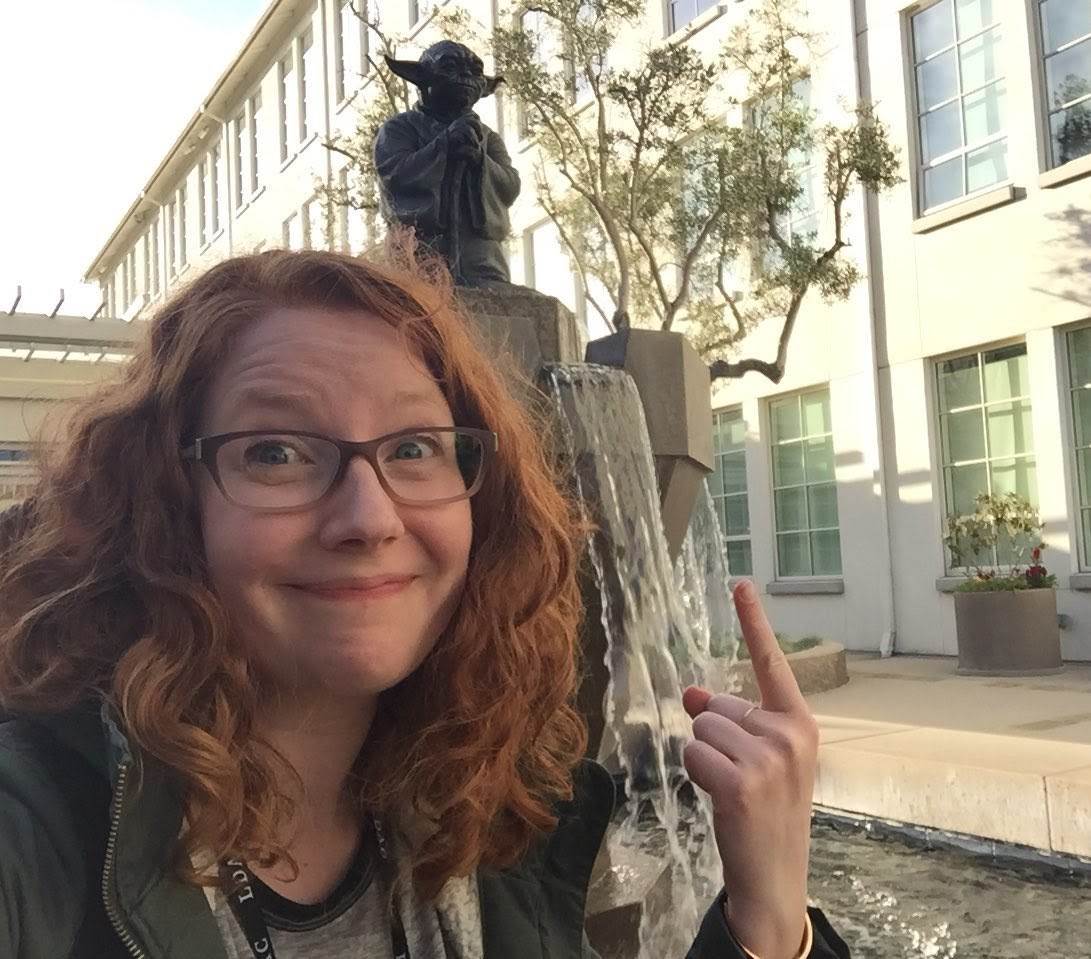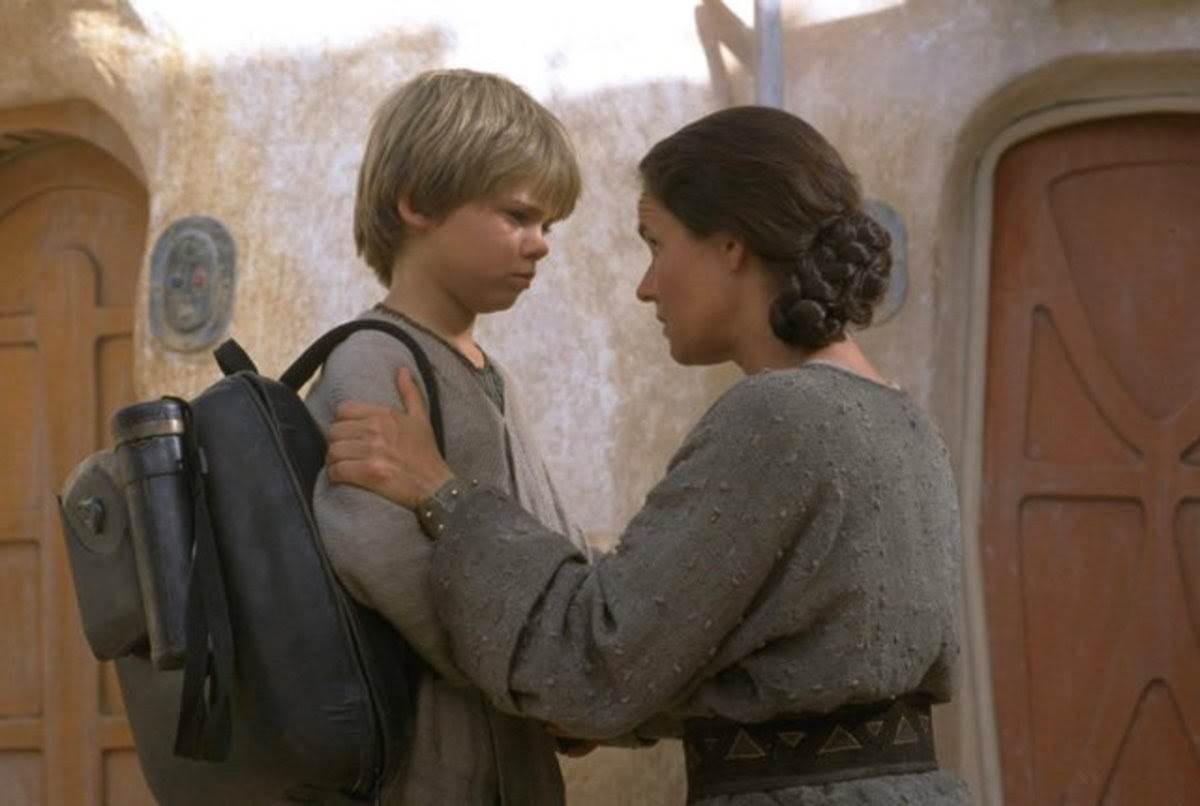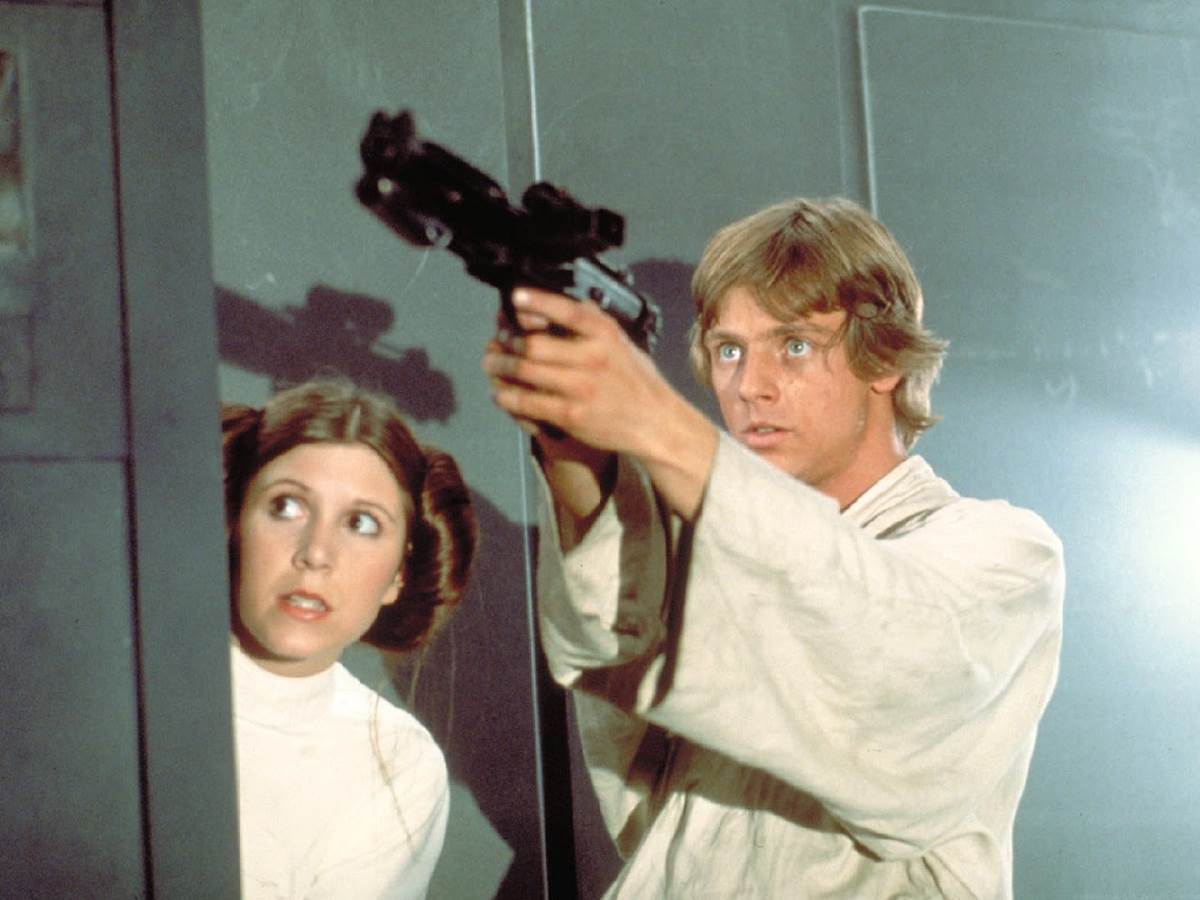Interview – “This Week in Star Wars” Host Kristin Baver Discusses Her New Book “Skywalker: A Family at War”
Kristin Baver serves as the associate editor for Lucasfilm’s official website StarWars.com, but since early last year she has also hosted the weekly news webseries This Week in Star Wars for the George Lucas-founded company. And now she’s also written her very first Star Wars book, the fictional character biography entitled Skywalker: A Family at War.
This week I was lucky enough to interview Kristin Baver over Zoom about her career in Star Wars, what it took to get an entertainment news show off the ground during a pandemic, and how Skywalker: A Family at War came to be.

Image via @KristinBaver on Twitter
Mike Celestino, Laughing Place: What was your history as a Star Wars fan before you came to work at Lucasfilm?
Kristin Baver: I have to say first off I was a Star Trek fan. My dad introduced me to Star Trek: The Next Generation when I was about four years old, and we used to watch it together regularly. It was a great show for a kid to grow up with because it has so many ideals and values, and so many great characters, but also I remember very distinctly having my little mind blown when I realized LeVar Burton had another job besides Reading Rainbow, because that was what I had known him from. [laughs] So I got into Star Trek. We watched it a lot as a family; we watched the original series in syndication. We went to a Star Trek convention when I was nine years old, just absolutely adored that franchise… still do, but Star Trek was a bit of a gateway to me with other science fiction and fantasy.
When I was about late elementary school age is when I actually discovered Star Wars, so quite a bit later in life, but there was something about Star Wars that I really just latched onto, that I really loved about it, that was so different from what Star Trek presented. And I know people love to debate Star Trek or Star Wars-- you can have both. You can love both; there’s room in your heart. So it was my dad, I think, who picked out my very first Power of the Force action figures for Christmas one year. I got a very buff Chewie [laughs] and an R2-D2. And that just opened up a whole other world of Star Wars collecting and really getting into-- beyond watching and rewatching the movies-- having this sense of Star Wars ownership in the off-hours. I could make my own stories. I could explore the stories deeper than what was just presented in the span of a film.
LP: How did you accomplish achieving your role as associate editor of StarWars.com?
Baver: As Obi-Wan says, there’s no such thing as luck. But I’m sorry Kenobi, there was definitely luck involved. I feel like he’s a little bit wrong on that one. I was freelance for about a year and a half for StarWars.com on the news and blog side before my position even opened up. So that was a huge help in getting me not only in the door but to the top of the pile of resumes, because I know there were just hundreds of people who applied for this job and would have been great for this job. I feel very fortunate that I managed to even get an interview, but for sure that I managed to clinch it. But before the position even opened up, and I think before I was a freelancer for StarWars.com, it’s important to know that I was a journalist for over a decade, so I had that news background. I had that writing background-- I had been writing articles pretty much every single day of my life after I graduated from college. So I think all those things came together to make me the right person at the right time for the associate editor role.
LP: This Week in Star Wars launched on YouTube just before the pandemic hit last year. How was that adjustment challenging for you and the creative team behind the show and what has that experience been like for you otherwise?
Baver: So bizarre and so challenging, but also so rewarding, creatively. We were eight weeks into This Week in Star Wars when we got shut down in San Francisco for the pandemic, which isn’t a lot of time for any show but was especially not a lot of time for me and this show because I was new to being an on-camera host. I was new to doing the weekly scriptwriting. I was definitely new to all the technology that comes into the production side of things. So all of a sudden, within the span of a week, we had to pivot and move everything to a corner of my living room, and get up to speed with how we could make this show continue to work without missing a beat. I’m so incredibly proud of the work that we have done, as well as the team behind that at StarWars.com.
They’ve been so great about answering questions and teaching me how to capture b-roll when I needed to be the one to do it because I had whatever the item was in my house and no one else could come in and see what it was. [laughs] So they’ve just been incredibly patient and wonderful to work with behind the scenes. And then for sure in front of the camera, after those first eight weeks-- or maybe even towards the end of those eight weeks-- I had started to get a little more comfortable with it. But I definitely feel like I’ve found more of what the voice of that show needs to be… what my own energy in front of the camera can be. I’m not a big “persona” person. I tend to think that authenticity is so much more important than portraying yourself in a certain light. So for me it was really just trying to tap into that genuine excitement for everything that we were talking about without making it into “Kristin Baver the Host.” [laughs]
LP: As a fan of Star Wars toys and knick-knacks I’ve admired your set decoration skills using different items from your own personal collection of memorabilia each week.
Baver: I tell you, that was a great idea on week one. I think we’re on week 56 now, and every time I have to redo the set I think, ‘Why did we start doing this?’ I mean, I have plenty of toys and sometimes I make dioramas with it. I don’t know if anyone notices, but one week Chewbacca was reading a book to one of the Porgs, and C-3PO was having a conversation with Jabba. Clearly this is all my lockdown brain formulating things on the set, but I’m having a lot of fun with it. When we first pivoted to doing it from home, there were so many very serious things happening in the world, and because I come from a general hard-news background, at first it felt a little weird to continue shouting about Star Wars in a corner of my house while the world was really crumbling around us, in some ways. And that feeling persisted for a lot of 2020, but very early on I realized through talking to people that it’s also incredibly important to have that levity… have those moments of something that isn’t the news and everything grueling that’s happening in the world. So that made me feel better about continuing to produce something that was silly.
LP: How did the idea for Skywalker: A Family at War come about? Was this something you came up with or were you approached with the project by Lucasfilm Publishing?
Baver: I know the idea was percolating when I came into the mix, a little bit. We had the title, we had the notion that it should be a biography spanning all three generations. I think we knew that the timing was right for that because it was shortly after The Rise of Skywalker had come out, so we knew how the Skywalker Saga ended. It was a great time to revisit that family. From there, I really made it my own in terms of, ‘Well, what does that mean? What does Skywalker: A Family at War tell you? What’s the story that we’re telling through this?’ We knew very early on we wanted to pull from not only the films, which have some of the most pivotal moments for this family, but also the books and the comics and the animated series and any kind of lore that really helped enrich our experience of who these individuals were. So just taking that and making it my own and trying to figure out a good way to put all of that in about 300 pages, which is a tremendous amount of storytelling to try to bring all together in one book.
LP: How much of the book came from your own existing knowledge and how much research did you end up doing to fill in the gaps-- if there were any gaps?
Baver: There were definitely gaps, and a big part of it is because Star Wars is such a living, breathing organism. Even as I was writing the book, there were other authors in other sectors that were creating Star Wars stories that were impacting the Skywalker family. So it was a really interesting mix of trying to balance all of those narratives and all of those pieces. For example, as I was writing it, concurrently the Marvel Star Wars [comic book] run that takes place between The Empire Strikes Back and Return of the Jedi was starting to come out. I couldn’t know what those creators had in mind or necessarily had in store all the time. I was able to get some early sneak peeks of things, so we could weave in what made sense from a storytelling perspective.
There’s new stories being created for Star Wars all the time, and sometimes they’re going to involve the Skywalker family in one way or another and these characters that we already know. Or in the case of the [Obi-Wan Kenobi Disney+] series, they’re going to involve someone who is tremendously important to the Skywalker family. So it’s really just a wait-and-see for where that new lore takes us, and then-- I hope, at some point-- we get to revise this book… five, ten years down the line, and add all those new stories in. But for the most part we were really sticking to the broad strokes I knew, just from being a fan and from my job. So I knew at the beginning where the story began, where it ended... roughly what the trajectory was for all three parts. And then from there it was rewatching and reading and rereading and making sure that I was revisiting things with that in mind.
Because I’ll tell you, Star Wars: A New Hope looks different when you’re looking at it trying to figure out, ‘How is Luke feeling right here?’ or ‘What’s going on in Leia’s head?’ And you know what she’s going to do, so you can kind of parse it out, but it’s a bit of a different lens and it’s a bit of a different perspective than any other time I had watched that movie. And the same goes for all of the Saga films-- as I rewatched all of them, I kept thinking, ‘Okay, what’s going on here? What’s this little detail that maybe I’ve missed before?’ This probably happens to you, but every time I watch a Star Wars movie I see something I didn’t see before. So this was like that baseline experience, but I was looking for very specific things as I was watching it.
LP: I love that, as you said earlier, the book incorporates story points and information from the Star Wars novels, comics, and TV series in addition to the movies. Why was that important to you as the writer?
Baver: The Clone Wars does so much work to explain Anakin’s fall, as well as Anakin and Padme’s relationship that exists in a pocket of time that we don’t see in the films. So without those seven seasons of animation, you miss a lot of what’s happening for Anakin Skywalker, who’s extremely important, especially to this book. It was really important to me to make sure that we were weaving in all of those pieces because they really enrich those characters and they deepen your understanding of them. And I know not everyone is reading every single book and comic that comes out. Not everyone has seen all of The Clone Wars. There are some fans who have also not seen every Star Wars movie yet, you know? They’re still working through it. So it was important to me in this book that we gave you everything that you would need to know if you were coming at it relatively fresh-- maybe you just discovered Star Wars and you happen to get this book, and I wanted to make sure that that reader understood it and there was something there for them. But maybe you’ve loved Star Wars for over 40 years now, and you were at the theater in 1977, and I also wanted to make sure there was something for that reader.
LP: Along the same lines, who would you say is the target audience for this book? Did you write it with more hardcore or casual fans in mind?
Baver: That’s a great question, because I think as I said we did try to craft it in such a way that if you were super casual [or] if you were super hardcore there was still something there for you, but honestly the fictitious hypothetical reader I had in mind was me when I was twelve years old. And there’s an impossibility, unless we get a Tardis in here, that I can go back and give myself the book and enjoy it at that age. But me at twelve or a kid like me who was discovering Star Wars through the films, got really hooked, and wanted to know everything that there could be to know about these characters that they loved so much. I think it’s written in such a way that a twelve-year-old could pick it up and digest it and enjoy it, but I also wanted to make sure we weren’t talking down to kids and older kids but also making it something that adult fans could pick up and still enjoy. It would speak to the twelve-year-old in all of our hearts.
LP: What do you think it is about the Skywalker family that makes them so interesting?
Baver: I think if you’re in Star Wars-- if you exist in that galaxy-- the Skywalkers have that legendary status. Even though it’s a big galaxy and there’s a lot of planets, and there’s certainly pockets of the galaxy where they have never heard of the Skywalkers-- they would not read this book; they don’t know what this book’s about-- but I think the Skywalkers had such a tremendous impact on galactic events that they’re analogous to other families or dynasties in our own world. I have no interaction with the House of Windsor, is the example I keep coming up with, but I watch The Crown and I certainly know who the queen is, and I know everybody else in that family at a distance. I feel like the Skywalkers in A Galaxy Far, Far Away are similar to that.
LP: What do you hope readers get out of Skywalker: A Family at War?
Baver: The lofty part of me wants to say that I hope it changes their perspective a little bit on their next viewing, which is not something I had thought about until we were doing another interview and the interview said that the book had changed his perspective on Anakin in The Phantom Menace a little bit. And I was a little overwhelmed in the moment to even think about [the idea] that something I had written might shift someone’s perspective, but now that has become my lofty goal for the book. That people will read it and it might shift their perspective a little bit in their next viewing, or their next reading of one of the other books that we pull material fro-- the events in those books. We certainly are not going to do a retelling of [Claudia Gray’s Star Wars: Bloodline] in the span of maybe about a page and a half [that] the Bloodline events come into my book. But I hope it also makes people reevaluate what they think they know about the family. I know in the process of writing it I came away with so much more compassion for Anakin and for Ben Solo. My hope is that some of that is telegraphed and comes through in the writing as well so that people who just see them as “Anakin Skywalker becomes Darth Vader; he’s bad” will revisit that a little bit and see some of the nuance. But mostly I just hope that they enjoy letting me take them on this journey through the lives of the Skywalkers.
Skywalker: A Family at War is available now from DK and Lucasfilm Publishing wherever books are sold. This Week in Star Wars is released each Thursday afternoon on the official Star Wars YouTube channel. The audio version of this interview will be featured in Laughing Place’s Star Wars podcast “Who’s the Bossk?”





